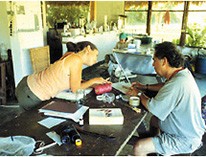Students inventory rain forest for its medicinal benefits
By H. Roger Segelken
Cornell students' biological inventory of a rain forest tract in the Amazon is revealing the chemical strategies of organisms that survive in one of the planet's most competitive environments.
Somewhere among the hundreds of natural compounds the students are identifying -- or in the wisdom of the rain forest native peoples they are consulting -- could be the next breakthrough medical treatment. In the meantime, the students are learning more science from their jungle experience than any campus classroom can offer.
Each summer, some two dozen undergraduates, under the direction of environmental studies Professor Eloy Rodriguez, set up operations at Campimento Yutaje, a remote eco-tourism camp in Venezuela's Amazonas state. Yutaje is accessible only by aircraft or dug-out canoe, but once there, the fieldwork venues could not be more convenient. A few steps from the palm-hatched huts where the students sleep and conduct their bioassays, the inventory begins. And minutes away by river are the homesteads of their ethnobotany collaborators.
Chemical analysis, rain forest-style, is low-tech but reasonably accurate. Kitchen blenders are the first step in the analytical process, in which TLC stands for thin-layer chromatography. TLC gives students a rough idea of which chemical compounds they are finding; precise identification requires the sophisticated instruments at IVIC, the Venezuelan scientific institute in Caracas that supports the Cornell program.
For the students, a coveted midsummer trip to IVIC can answer two questions: Do the newly identified chemicals have medicinal potential? And, does civilization still exist?
Again this summer, Cornell students will head back to Yutaje to resume the quest.
Media Contact
Get Cornell news delivered right to your inbox.
Subscribe